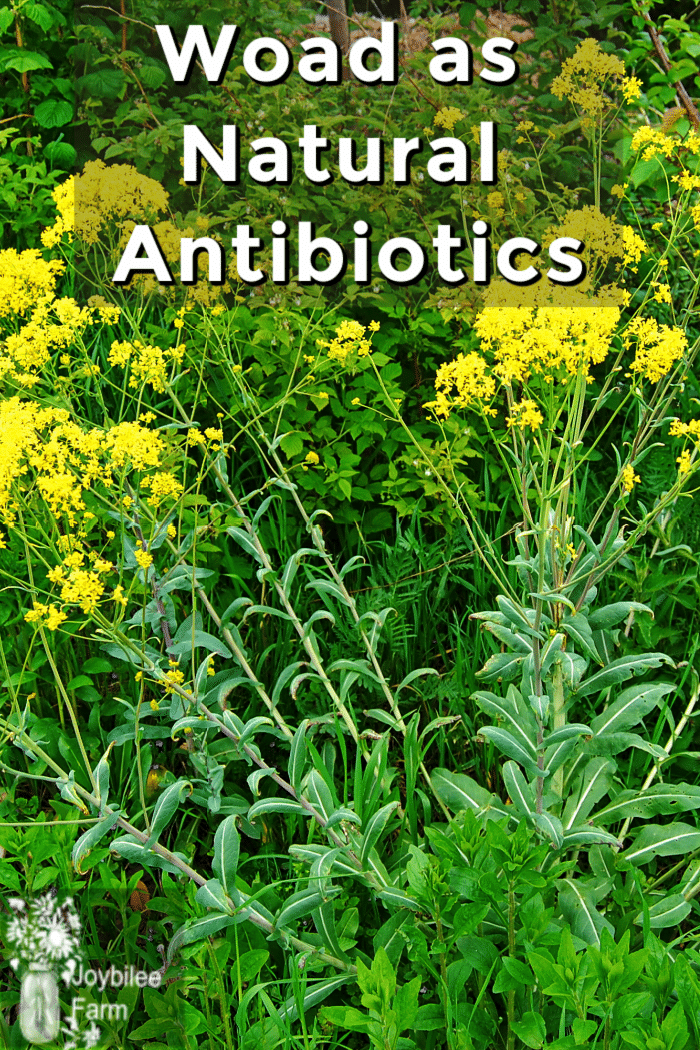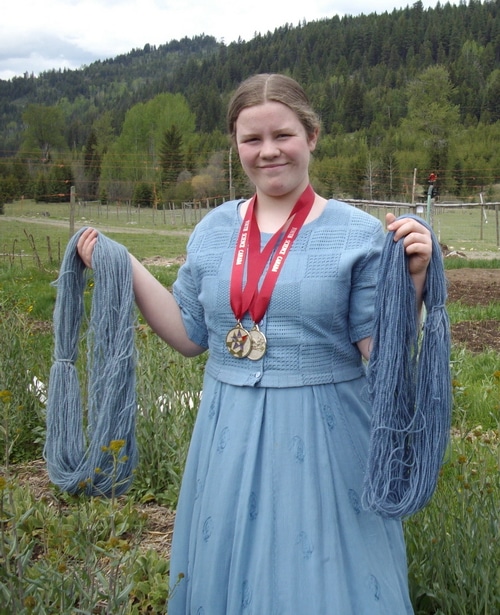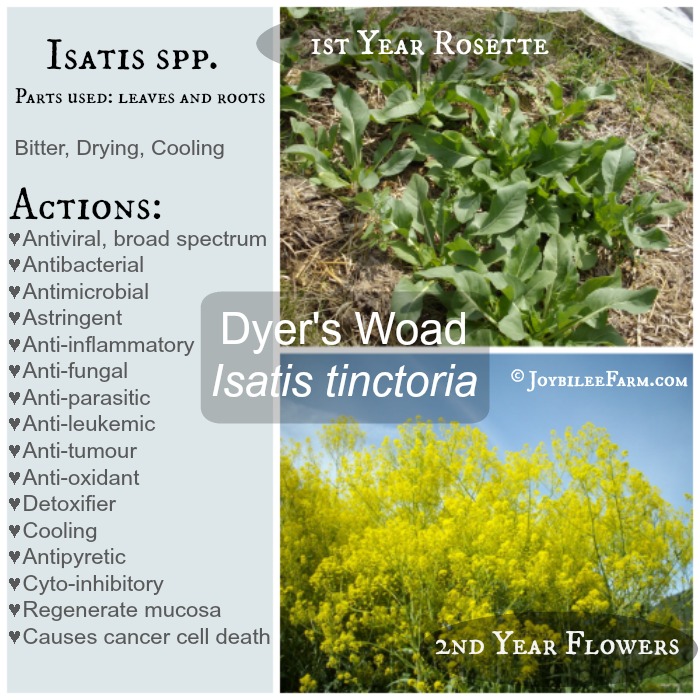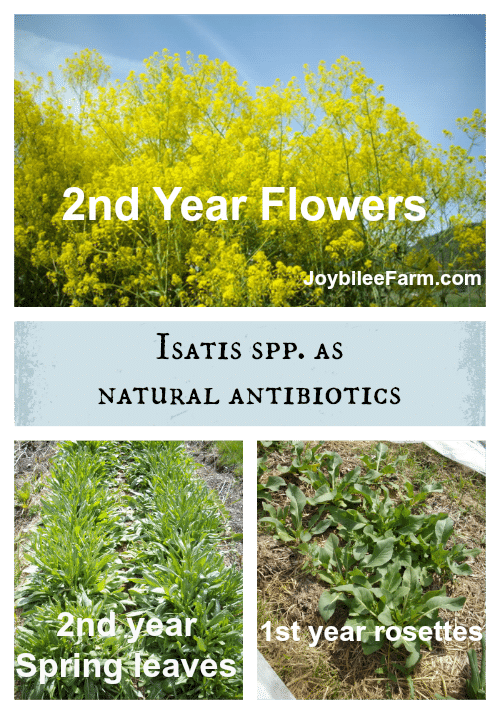Woad as Natural Antibiotics

Isatis tinctoria for a broad spectrum antibiotic
Today I have a guest post on the Herbal Academy of New England blog about using one of my favourite herbs, Dyer’s Woad, as a natural antiviral. It works so well as an antiviral because it is also a natural antibiotic and so it prevents secondary infections. Woad and other Isatis spp have been used in Traditional Chinese Medicine for thousands of years for their unique ability to prevent viruses like influenza and measles from replicating in human cells. Check out my post to find out more about this unique and generous plant.
My relationship with Woad
My own love of woad began 15 years ago when we grew our first woad plants for dye extraction. Making friends with other woadies around the world, including Teresina Roberts of the UK, encouraged my daughter to launch an all-consuming science project that took her to the medals podium at the Canada-wide Science Fair 2 years in a row. Together, we’ve explored every aspect of woad from the historical significance, cultivation, natural dyeing, economics, and medicinal use. Find out Sarah’s unique technique to extract the most dye from Woad’s first-year leaves at WearingWoad.com.

At the same time, we’ve had passionate conversations with Barb, the “Weed Lady,” regarding the invasive nature of Dyer’s Woad and our own efforts to keep any plants we could grow successfully in our harsh zone 3 climates, contained, to prevent contamination of surrounding pastures. No worry there. Our goats and sheep love woad down to the very last mouthful. It doesn’t stand a chance outside of our fenced garden area.

A brief history of woad
Isatis tinctoria or dyer’s woad is an easy to grow biennial that originated in the Caucus area, near Turkey. It was valued for its rich blue pigment and archeological evidence traces its use as a natural dye back to the Neolithic period in France, the Bronze age in Austria and Germany, the Iron Age in Northern Europe and the British Isles, and the Pharaonic period in Egypt. Woad-dyed textiles were found in the pyramids that still showed the blue colour after thousands of years.
Even after the invention of modern chemical dyes, woad continued to be used commercially along with natural indigo to dye the military and police uniforms of Europe, until the last woad mill was closed during the Great Depression. But the story doesn’t end there. Woad continued to be used by gardeners, artists, and hobbyists throughout the 20th century. Today there is a small-scale commercial resurgence in UK and Europe, where woad is being explored as an eco-friendly blue dye, inkjet pigment, and medicinal herb.
Phyto-policing
Dyer’s Woad can be invasive. It is considered noxious in 8 states and in parts of Canada. It’s on the watch list in BC. If you decide to grow it, please use the first year plants and harvest the root before it flowers. If you plan to save seed, do keep at least 4 plants for seed, to ensure the vitality of the seed, but only allow one flowering stock from each of the plants to remain. Prune off the other branches at the crown, as soon as you see the broccoli-like florets emerge. Harvest the seed when it turns blue-brown, and dry it in a safe area where the wind can’t scatter it recklessly. Better yet, if you are in zone 5 or warmer, grow Isatis indigotica, Chinese Woad, and leave Dyer’s Woad for harvesting from the wild. All Isatis spp. are used interchangeably for herbal medicine

Isatis spp as a broad spectrum antibiotic
Isatis has a broad range of tested antimicrobial actions against Toxoplasma gondii, Plasmodium falciparum, Leishmainia spp., Trichophyton schoenieinii, Aspergillus niger, Candida albicans, Trichophyton simii, Macrophomina phaseolina, Bacillus pasteurii, Bacillus subtilis, B. spharericus, Pseudomonas spp., E. coli, Samonella spp, Staphylococcus spp. Streptococcus spp. and Clostridium difficile.
How to use Isatis as a natural antibiotic:
Make a decoction of the root
Make a decoction of coarsely ground root using 1 oz. of root to 8 oz of water. Simmer for 15 minutes with a lid on the pot. Turn off the pot. Allow it to steep for 15 minutes. Strain and drink 1 cup 3 times a day.
How to make an Isatis spp tincture
Check out my post on HANES for the special technique I use to make a tincture with Isatis spp leaves and roots.

I hope you’ll consider wildcrafting woad leaves, and roots or adding them to your garden, to appreciate their antiviral and antibiotic virtues as well as to enjoy woad blue — a unique colour that can’t be duplicated with chemical dyes.
If you are looking for directions on how to extract the natural indigo dye from woad, see Sarah’s instructions at WearingWoad.com

References:
Buhner, Stephen Harrod. Herbal Antivirals, natural remedies for emerging and resistant viral infections. Storey Publishing: North Adams, Ma, 1913. Pp. 192-208.
Cardon, Dominique. Natural Dyes, sources, traditions, technology, and science. Archetype Publications: London, 2007. Pp. 367- 376.
Shu-Jen Chang, Yi-Chih Chang, Kai-Zen Lu, et als. “Antiviral Activity of Isatis indigotica Extract and Its Derived Indirubin against Japanese Encephalitis Virus,” Evidence-Based Complementary and Alternative Medicine, Volume 2012 (2012).
Yang Z, Wang Y, Zheng Z, et als. “Antiviral activity of Isatis indigotica root-derived clemastanin B against human and avian influenza A and B viruses in vitro,” International Journal of Molecular Medicine [2013, 31(4):867-873].
Zifeng Yang, Yutao Wang, Shan Zhong, et als. “In vitro inhibition of influenza virus infection by a crude extract from Isatis indigotica root resulting in the prevention of viral attachment,” Molecular Medicine Reports, March 2012, Volume 5 Issue 3



There are a lot of wild mustards. Not all are dyers woad.
How can I tell which plants that look like this are good dyers woad, from the kind that is poisonous to horses? I have some coming up wild. I’ve always called it mustard and now find out that woad is a kind of mustard. Scarey! Are there kinds that are NOT poisonous to horses? Your site says it can be used for medicine for people. Crossing fingers the safe ones are the ones I have. Mine have not spread in 35 years. I’ve tried cultivating it for the yellow flowers, but it stays in one spot. Your website says it gets rampant. I’ve had a lythrum in the same one square foot of ground for the same 35 years, and its called pernicious here and can’t be sold as a garden plant here. The state’s classification is confusing. You grow the stuff, so I am hoping you have the answer.
Hi, I hadn’t heard about this herb until recently. Do you know where to buy some from? I’ve checked mrh, starwest botanicals,etc. but haven’t been able to find a source for it. Looking forward to making and having this in my herbal medicine collection.